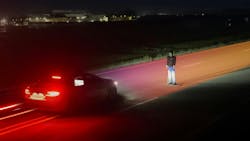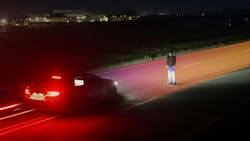Thermal Imaging Helps Automakers Meet 2029 Nighttime AEB Safety Standards
What you'll learn:
- What is a PAEB system?
- Teledyne FLIR and VSI Labs PAEB testing plan.
- Results from vehicle testing.
If you’re unaware of the escalating problem of pedestrian fatalities in traffic crashes, let me throw some numbers at you: Pedestrians accounted for about 17.7% of traffic deaths in 2022 and 77.7% of pedestrian fatalities occurred at night that same year.
To mitigate this quandary, the new Federal Motor Vehicle Safety Standard 127 mandates that by September 2029, all passenger cars and light trucks with a gross vehicle weight of 10,000 pounds or less must have pedestrian automatic emergency braking (PAEB) systems. The standard requires all cars to be able to stop and avoid contact with a vehicle in front of them at up to 62 miles per hour. In addition, the systems must detect pedestrians in both daylight and darkness.
The standard also dictates that the system applies the brakes automatically up to 90 mph when a collision with a lead vehicle is imminent, and up to 45 mph when a pedestrian is detected. It further specifies that—when tested—these systems detect pedestrians in various lighting conditions, at increased vehicle speeds, and with a 100% pass rate.
AEB systems use sensors to detect when a vehicle is close to crashing into a vehicle or pedestrian in front and automatically applies the brakes if the driver has not. Pedestrian AEB technology will detect a pedestrian in both daylight and in darker conditions at night. This will significantly reduce injury or property damage and associated costs from these crashes. The National Highway Traffic Safety Administration (NHTSA) projects that this new standard will save at least 360 lives a year and prevent at least 24,000 injuries annually.
Evaluating PAEB Systems
Teledyne FLIR, in collaboration with VSI Labs, released its testing plan methodology along with the results of its FMVSS No. 127 PAEB tests. The primary objective was to evaluate the performance of a thermal-fused PAEB system and several 2024 commercial-off-the-shelf (COTS) PAEB systems under both daytime and nighttime conditions utilizing FMVSS No. 127 PAEB testing scenarios.
VSI Labs tested the performance of a thermal-fused PAEB system on a Ford Fusion Hybrid research vehicle and three current state-of-the-art 2024 COTS PAEB systems. The thermal-fused AEB sensor suite featured Teledyne FLIR’s latest longwave-infrared (LWIR) automotive thermal camera, an automotive HD radar, and an automotive visible camera. All three 2024 COTS vehicles use a combination of radar and/or visible camera(s) and don’t include a thermal camera. Test results revealed:
- Daytime PAEB performance: Both thermal-fused and COTS PAEB systems passed all daytime tests.
- Nighttime PAEB performance: Only the thermal-fused PAEB system passed all nighttime tests, demonstrating detection capabilities independent of headlight performance.
- Thermal active pedestrian test mannequins (PTMs): Commercially available, heated, thermally active PTMs offered a realistic representation of a human thermal signature and are recommended for future PAEB testing protocols using thermal cameras.
The test data showed that LWIR thermal cameras see multiple times farther down the road than headlights illuminate, providing advanced warning of objects, vehicles, pedestrians, and large animals in the roadway. Advanced warning leads to extended braking distances (especially important for heavier vehicles), improved detection and false-positive performance, as well as more comfortable and safer deceleration.
Vehicle Test Results with Different Systems
VSI Labs’ research vehicle, which included the latest AEB thermal camera from Teledyne FLIR, successfully passed all tests, while three new 2024 vehicles failed two or more nighttime tests. Testing conducted by VSI Labs highlighted the challenges faced by conventional PAEB systems that rely solely on radar and visible cameras.
The thermal-fused system, integrating Teledyne FLIR’s LWIR camera, demonstrated detection capabilities independent of headlight performance. Phil Magney, founder of VSI Labs, emphasized the importance of thermal cameras in addressing real-world scenarios and ensuring reliable PAEB performance across all vehicle sizes and weights.
“VSI Labs’ testing showed that all three COTS vehicles failed at least two or more test scenarios at night, indicating that meeting the standard will be challenging using the current top-rated PAEB systems on all vehicle sizes and weights,” said Magney. “Furthermore, real-world corner cases are potentially more challenging, emphasizing the value of automotive thermal cameras for true-positive and false-positive PAEB performance. VSI’s testing shows that thermal-camera technology exists to help automotive manufacturers meet FMVSS No. 127 requirements by 2029 and make roads safer for pedestrians.”
VSI conducted all tests at the American Center for Mobility (ACM) in Ypsilanti, Michigan, on September 10 and 11, 2024, during the day and at night.

